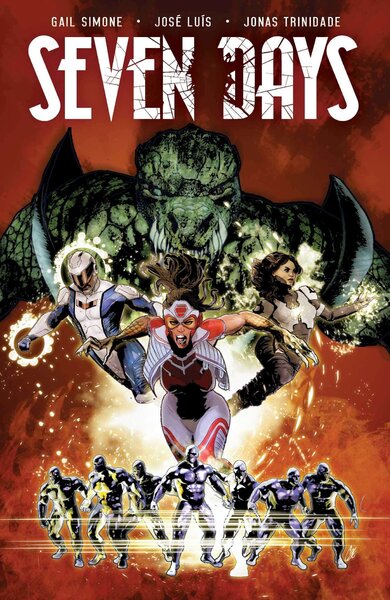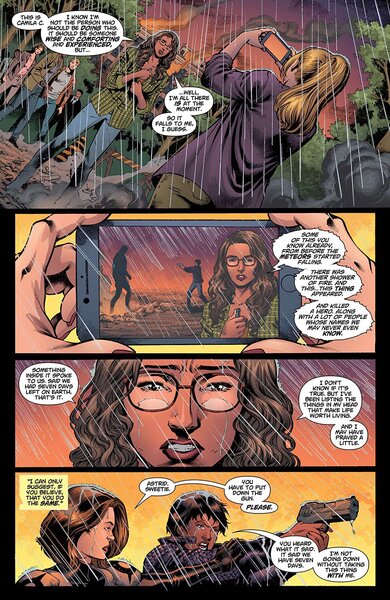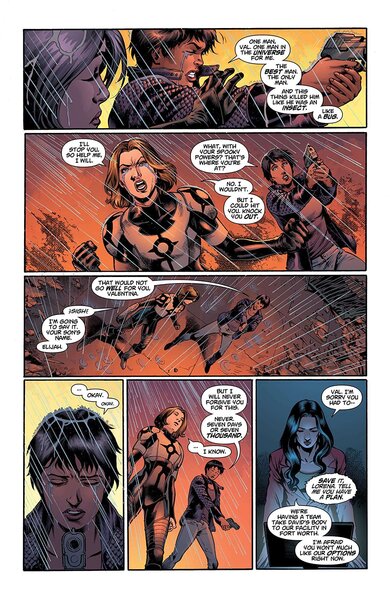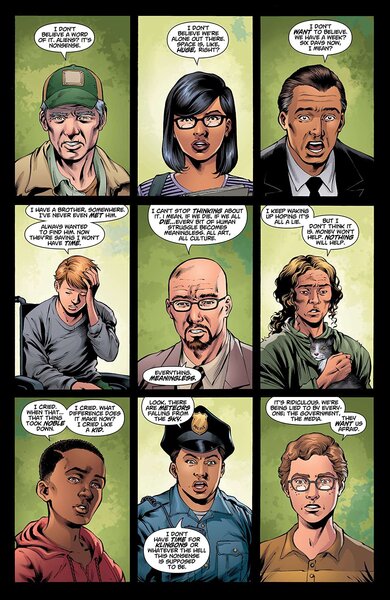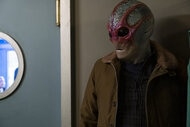Create a free profile to get unlimited access to exclusive videos, sweepstakes, and more!
Indie Comics Spotlight: Gail Simone on how Seven Days crossover channels Crisis On Infinite Earths
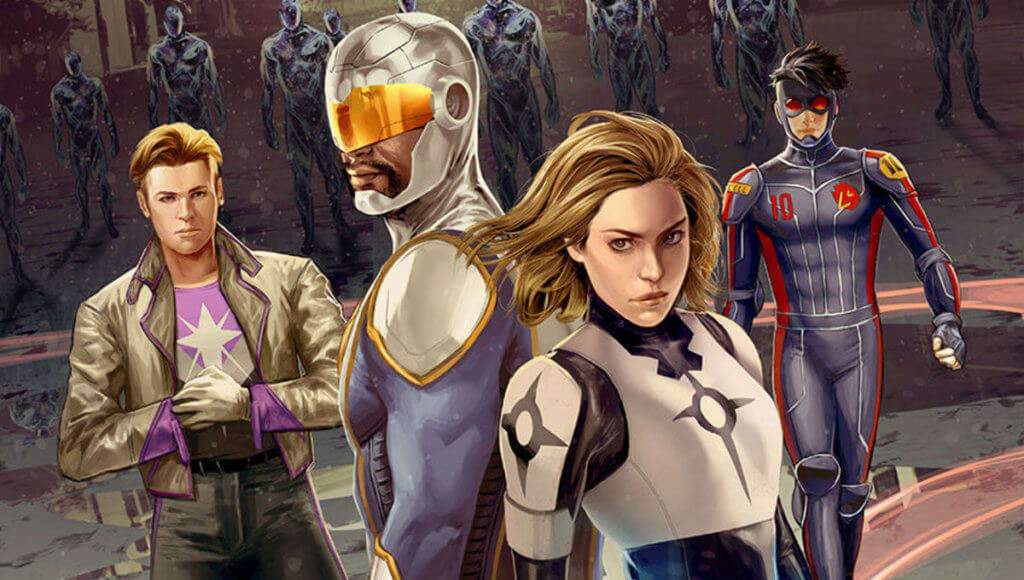
In the last two decades, Gail Simone has written over 600 comics and created over 30 characters in both mainstream and indie comics. Her ability to create compelling storylines while reshaping classic ones for new audiences is just part of her mystique. So when Lion Forge tapped her to helm the Catalyst Prime: Seven Days crossover event, it not only leveled up the small publisher as a legit player in the comic book game, but it meant we were getting one hell of a story. Since the collected volume of Seven Days drops this month, we thought we’d take a look at how it was developed, and how it became one of the best-reviewed comics of the past year.
In 2018, Simone was announced as the new “Architect” of Catalyst Prime, filling the void left by former Executive Editor and Catalyst Prime creator Joseph P. Illidge. Last year at San Diego Comic-Con, Lion Forge announced Seven Days, explaining that the idea was to create a crossover event spanning seven issues that would shake the foundations of the Catalyst Prime Universe (CPU), and attract new fans to the franchise and characters like Accell, Noble, Cosmosis, Quincredible, and KINO. The timing couldn’t have been better, because shortly thereafter, the St. Louis based company bought out and merged with Oni Press, making this series the first big project under new parent company Polarity.
The premise of Seven Days is simple. An alien conqueror attacks Earth because its homeworld is dying. It announces that humans have seven days to vacate the premises and say goodbye to their loved ones before the planet is cleansed down to the molecular level. Some people think it’s fake, others race to find their families, while an elite few superpowered humans take it seriously and acknowledge that the threat bears a striking resemblance to The Event, the cataclysmic incident that ignited their powers in the first place years before. Needless to say, they fight.
But not without losses.
Simone says that as a little girl, Batgirl on the Adam West Batman show was a game-changer for her, because she saw a strong female character with bright red hair like hers, whom she could relate to. That influence is evident in this arc as storylines balance heroism with humanity and community. The veteran storyteller brings that sense of inclusion to her work with Lion Forge as well, as the team she assembled to build Seven Days was just as talented and diverse as the characters that they were creating –– including the stunning art team of José Luis (Aquaman) and Jonas Trindade (Arrow), along with colorist Michelle Madsen and Eisner Award-winning editor Desiree Rodriguez (Puerto Rican Strong).
In an email interview with SYFY WIRE, Simone tells us about what it was like keeping track of an army of characters for Seven Days, and how she was able to attract both new and old fans to the Catalyst Prime series.
It’s been just over a year since Seven Days was announced — the first major event of the Lion Forge imprint. Looking back at it now, do you feel you achieved your goals with this series?
Gail Simone: Artistically, absolutely, it’s one of the best-reviewed superhero books of the past year, the art is phenomenal. But it did end during quarantine and that put a lot of major franchise books in a difficult spot. I think it’s a lovely, action-packed, and emotional read.
My goal was to present this beautiful universe to new readers, we definitely did that. And I think it’s just a ripping tale, I can’t wait for the collected version.
These characters were co-created by writers like Amy Chu and Christopher Priest, but they’d never really been in the same big story before. It was intimidating, but I loved it. Noble, Quincredible, Summit — I’ve just grown to love them.
What was the most challenging aspect of creating a crossover event like this?
It’s a lot of history. It’s not necessary to know all that to read it, but it’s absolutely essential to write it. We’re talking several volumes of seven series, it’s a lot to remember. I had just endless pages of notes, and it’s a tricky balancing act because you don’t want it to sound like the History Channel. Also, I wanted each character to have a shining arc, something that belonged to them.
Most of the CPU characters have the same origin, they were astronauts given powers in the same event. So it was also vital to make each stand separate from the pack.
This story is easy to follow for new readers as well as full of easter eggs for fans of many of the characters. What was your process to achieve that?
I had a great blueprint to follow, I went back to my favorite crossover event ever, the original Crisis on Infinite Earths. I wanted that kind of level of incident, where each page had a little story of its own. I didn’t want any moment to feel extended for page count. I love crossover events, but if they just follow the same pattern, it doesn’t feel like a love letter to the characters, it feels like an itemized bill.
The beautiful thing about the CPU is that it’s a universe created today, by a diverse team, in the Midwest. They may not even have realized it, but the books have a lot of that welcoming charm.
I deeply believe in comics for everyone, I want everyone to have books that feel like they were made for THEM, and in this case, keeping their history and personalities rock-solid felt like the way to leave that welcome mat out. When I read the books, that’s what I felt, like I was welcomed. I want people to feel part of our universe.
You killed off a couple of major characters. (Well, sort of.) How difficult was that choice?
Truthfully, it always sucks. I just don’t love doing it, if you look at the comics I have written over the years, I have killed very few established characters. Part of it just feels mean, I shouldn’t pull up the flowers I didn’t plant myself. But we felt there was a strong story reason for there to be some pain. And the CPU has always had the strict rule, if a character dies, they’re gone, they don’t come back. And they’d never really had to test that.
I think we gave them an ending worth remembering though, it haunted me for a long time.
The story covers a worldwide catastrophic event, what’s it like looking back at this story while we are experiencing one?
That’s exactly what happened, and it’s odd, because you go back and read the early issues and a lot of it feels like it’s referring to the pandemic, but of course, it was written months previously. I wrote a book called Clean Room, and people constantly tell me it’s about our current president, except it was written before that entirely.
But the upside is, it’s a story of hope in many ways, we can use as many of those as possible.
José Luís has an incredible classic comic book style. What was it like collaborating with him on this project? Did any of his choices inform your writing?
This is a lovely story. Lion Forge knew this was an important book, they said we could ask any artist we wanted, essentially. So myself and editors Desiree Rodriguez and Shawna Gore just went through STACKS of samples, including a lot of big names. People whose work I love.
But we all three of us, the same day, stopped when we saw Jose’s work. It had quiet moments, but it had the spectacle, something not all artists can do. We all three picked the same guy, from dozens and dozens. That’s always going to feel like fate.
We asked a friend, Joe Prado, for the perfect inker for Jose, and we got the amazing Jonas Trindade. I have worked with LEGENDARY artists and this was still just stunning, every time a new page came it. It was an honor working with those guys.
Will we see some of the new storylines and characters from this series stick around for a while in the Catalyst Prime universe?
Yes, can’t say much, but definitely we’ll see more from Tillian, Moonrise, and Khrelen, for sure.
What are you most proud of in this story?
It reminds me of how I felt reading Crisis on Infinite Earths for the first time, that lovely feeling of belonging to a special club that could appreciate this world, this universe.
